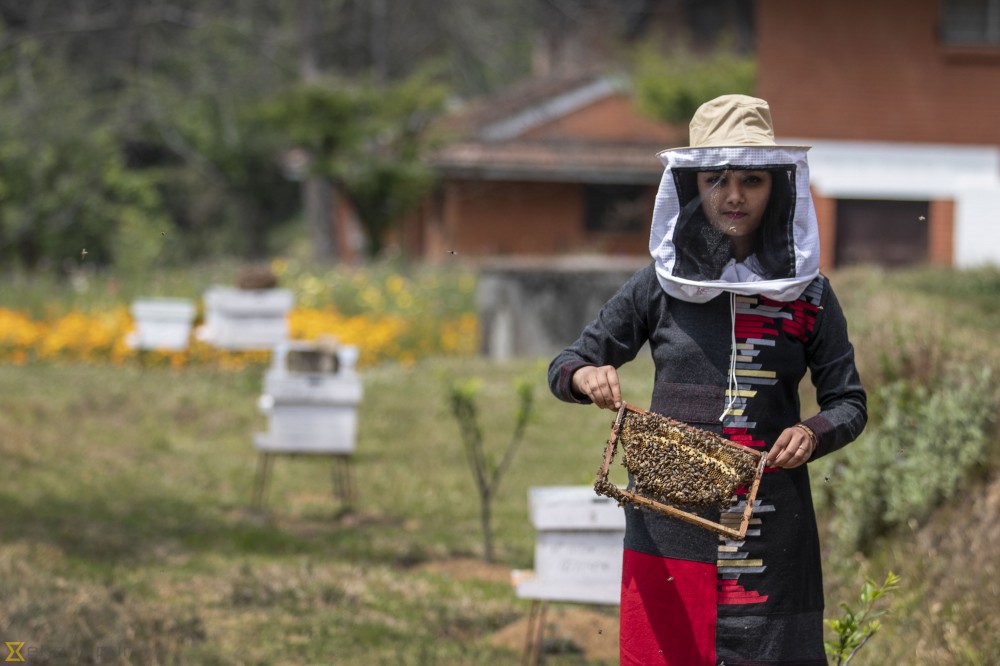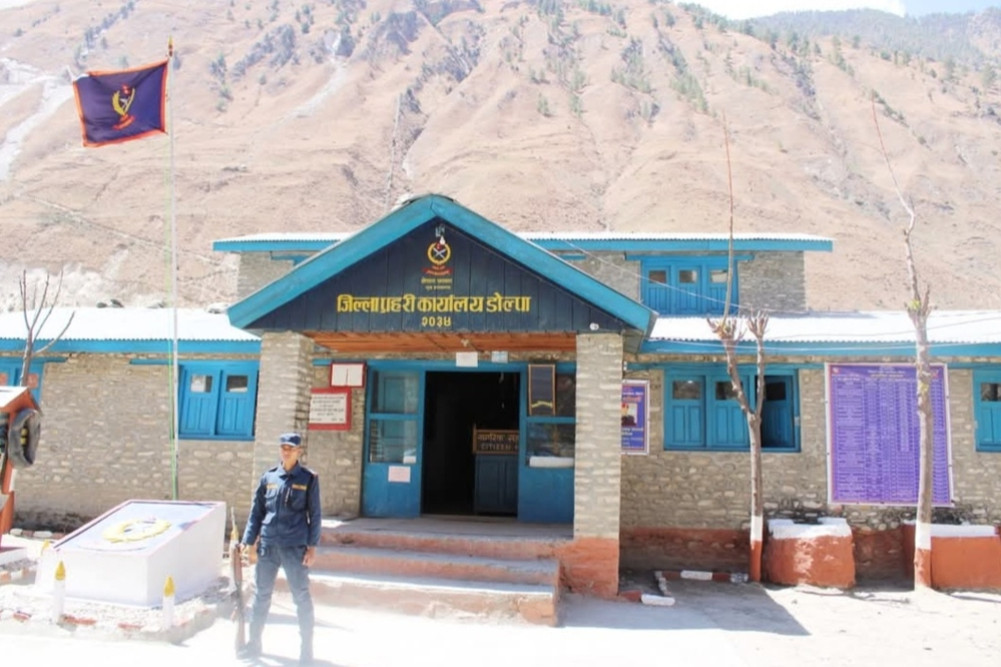National
Nepal’s honey and beekeeping industry is about more than profit
This phenomenon is not confined to Nepal--bees are dying all over the world. Colony collapse, a phenomenon where worker bees vacate a hive and leave behind the queen, has become more frequent. Climate change, destruction of ecosystems and pesticide use have all been cited as reasons but no clear consensus has emerged.
Thomas Heaton
Honey is in Bal Krishna Upadhyay’s lifeblood. Upadhyay’s family has been keeping Asian honey bees for generations. But last year was a bleak winter. His normally prolific bees had no honey.
“There were no new larvae and the bees were feeble and died,” says the Jumla beekeeper.
His bees’ lack of production is not an anomaly in Jumla, as a majority of beekeepers from around the north-western Karnali region are struggling. Upadhyay, who is also treasurer of the Karnali Beekeepers’ Cooperative, estimates that the local bee population has dropped by 90 percent.
This phenomenon is not confined to Nepal--bees are dying all over the world. Colony collapse, a phenomenon where worker bees vacate a hive and leave behind the queen, has become more frequent. Climate change, destruction of ecosystems and pesticide use have all been cited as reasons but no clear consensus has emerged.
International organisations and governments have made concerted efforts to help save the bees, emphasising the importance of apiculture for the future of their nations’ rations and global agricultural health. A recent article in the journal Biological Conservation predicted a “catastrophic collapse of nature’s ecosystems” because of the threats to insects—bees included. More than 40 percent of insect species, including honey bees, are in decline, says the paper.
Nepal’s burgeoning honey industry, and a growing government emphasis on sustainability, could bring about a decline in wild and domesticated bees, causing a ripple effect because bees pollinate 87 of the world’s most important food crops. The United Nations’ Food and Agriculture Organisation (FAO) has estimated the total worth of crops requiring pollination is between $235 and $577 billion.
Nepal’s topographical, climatic and floral variety should spell heaven for bees. Five of the world’s seven species of honey bee and several subspecies can be found here. However, the realities of climate change, increased pesticide use, and the introduction of the western honeybee are posing problems for the local population.
The changing weather has definitely affected his bees, says Upadhyay. Bee numbers started plummeting as far back as June or July, following spells of mud-rain. With 20 traditional wooden hives dispersed between three locations, Upadhyay earned Rs 350,000 from honey the year before last, but he fears another bleak year ahead.
“We are all very pessimistic. I do not even have one kilogram of honey this year,” he says. “Even the elderly say they have never witnessed a situation like this before. They are suspicious that it could be a bad omen for all human life.”
Changing climates
In response to the beekeepers’ complaints, a team from the Ministry of Agricultural Development’s Beekeeping Division visited Jumla in January, concluding that it was the weather and a lack of plant diversity that were affecting the bees.
“The temperatures go down to -10 degrees at times, so open pastures are a problem. The bees have nothing to forage on,” says Tirtha Kumar Shrestha, senior bee expert at the Beekeeping Division. “In many of the hives that have 21 frames, only four or five were being used. There’s just a little bit of honey, and even smaller amounts of pollen. The bees need to eat more to produce, but there’s not enough.”
But Upadhyay disputes one half of Shrestha’s conclusion, saying there might be a lack of flowers and plants but that has always been the case.
“This is the ‘dry season’,” says Upadhyay. “There is only one shrub called dhatelo and there are not enough flowers. But that cannot be the only reason because the availability of flowers was the same last year and there was a good harvest.”
The Beekeeping Division sent perennial plants to the area in early February to see whether they could act as sustainable food sources for the bees, but it is too early to tell if that will have an effect.
The lack of honey is a symptom of the degradation of the bees’ environment, with deforestation, human interference and climate change affecting where they source their food, say experts. But higher altitude areas should not have these problems, says Upadhyay .
Changing weather patterns, especially, are affecting beekeepers, says Shiv Prasad Sharma, president of the Nepal Beekeepers’ Association. This winter has been particularly difficult as Jumla farmers have simply been unable to predict environmental patterns, he says.
Native chiuri trees, which beekeepers heavily rely on, are blooming up to a month later in the mountains. Queen bees, vital to the production of honey and the health of hives, are being affected too.
For Suroj Pokhrel, a former secretary with the Ministry of Agricultural Development, climate change and habitat loss are two of the largest threats to Nepal’s bees.
The changing environment is the main threat to the giant honey bee (Apis dorsata), which is much more widespread than its subspecies, the Himalayan giant honey bee (Apis dorsata laboriosa).
“Within a period of 15 years, the migratory territory of the apis dorsata has moved into the laboriosa’s by 300 metres. It’s pushing up and up because of climate change,” says Pokhrel.
Destruction of nesting sites, forests, pesticide use and the reduction of local flora in the Tarai pushed the giant honey bee to the verge of extinction in the 90s, Pokhrel wrote in one study.

Nepal must be wary about the future of its bees—they are crucial to the country’s entire ecosystem. [Post Photo: Prakash Chandra Timilisena]
Pests and harvests
Pesticide use in Nepal is relatively low, at approximately 167g per hectare, according to the Beekeeping Division. However, the Plant Protection Directorate previously told The Post pesticide use was rampant in commercial agriculture, which directly affected their wild and non-wild bee populations. When bees come in contact with most pesticides, they either die on the spot or return to their hives, contaminating entire colonies.
“Until now, our mountain areas have been safe from chemicals. But in some pockets, apple farmers have started using pesticides,” says Pokhrel.
Uma Partap, agriculture and beekeeping specialist at the International Centre for Integrated Mountain Development (ICIMOD), agrees that pesticide use on cash crops, such as apples, does put bees at risk, but also argues that large-scale bee deaths are rare in Nepal.
“With proper training of both farmers and beekeepers, it is possible to save bees from the harmful impacts of pesticides and other agrochemicals,” says Partap.
In fact, ICIMOD points to the harvesting techniques of wild honey hunters that are affecting the population of giant Himalayan honey bees (apis dorsata laboriosa).
“Honey hunting during the honey flow season, and using appropriate methods, does not have any adverse impact on bee populations. But what honey hunters have been doing is harvesting the whole comb and all the colonies, forcing bees to leave the nesting site,” says Partap.
ICIMOD studied honey hunting practices in 2003 and found that several nesting sites had shrunk. Honey hunting was being used as a form of tourism, which was problematic because it led to out-of-season harvesting.
An invasive species
A less-studied but more prevalent problem for these bees, according to Pokhrel, is the ever-increasing amount of western honey bees (Apis mellifera).
Successfully introduced to Nepal in 1995, the number of western honey bee hives, prized for their honey-producing capacity, have multiplied quickly, infringing on the habitat of wild bees. Partap says western honey bees compete with—and sometimes interfere with—local species’ migratory patterns. And unlike the western honey bee, native species like the two giant honey bee species and the eastern honey bee (Apis cerana) maintain biodiversity better. This is because Apis cerana and wild bees are not loyal to certain plants while foraging but the Apis mellifera return to forage the same plants over the course of a season. The introduction of Apis mellifera has led to the virtual disappearance of Apis cerana in the Tarai region, according to Partap.
The introduction of the western honey bee was certainly good for the economy and the livelihoods of many, but a zoning plan is crucial for wild, native bees, says Mahalaxmi Shrestha, owner of The Beekeeping Shop. Shrestha has worked with bees on several projects since 1992, and has run her bee products shop since 1996.
“We need wild bees to conserve the biodiversity of wild areas. There are some flowers that can only be pollinated by the Apis cerana,” says Shrestha. Biodiversity is crucial to the country’s food system, but is in serious decline, according to the Food and Agriculture Organisation.
“If we continue with commercial beekeeping without any clear plans for indigenous bees, a time will come when the native bees will disappear,” says Shrestha.
One saving grace has been the fact that the western honey bee has not been successfully introduced above 800m, allowing native species to thrive in higher altitudes. Nepal thus has had a steady population of native honey bees at higher altitudes, compared to other countries around Asia. In recognition of the harm that the Apis mellifera is causing, the Nepal government implemented a zoning plan in 2016, and enacted a policy to promote the native Apis cerana in the plains and the lower hills, says Partap.
Learning to speak bee
Nepal’s beekeeping woes are not just limited to changing climates and invasive species, beekeepers themselves need an education, says Anchara Bhattarai, agricultural extension officer for the Beekeeping Division.
Knowing bee behaviour, how they react to changes in temperature or other variables, and how to sustainably harvest honey have long been issues that need addressing, she says.
“Two years ago, there was a lot of training, but this past year we have only had hive making,” says Bhattarai.
This year, there will be two programmes on a smaller scale due to cuts in budget. The division regularly ran seminars and programmes to train beekeepers on everything from constructing hives to best beekeeping practices, but the division is now solely focused on policy.
Bhattarai says it is up to local bodies to provide the necessary training, and beekeepers must make their demand for education known. For the most part, educational issues concern the Apis mellifera, because the Apis cerana has been reared for such a long time.
“What training there is, is very limited,” says Prakash Adhikari, owner of Beyond the Bee, a company that sources and sells honey from small-scale beekeepers around Nepal. “The training doesn’t give them the right information so they don’t know what exactly is happening to their hives.”
This lack of education extends further than the beekeeping population, as farmers have historically resisted having hives on their farms despite overwhelming evidence regarding the benefits of their presence. Adhikari says there have been instances where farmers do not let beekeepers place their hives on their land, and in some cases, even destroyed colonies.
In some countries--in Europe, North America and the Pacific, according to FAO--farmers pay beekeepers to bring their hives to promote good crops. But in Nepal, beekeepers who want to migrate their colonies to a denser floral area, such as another farmer’s plot of mustard or buckwheat, are charged up to Rs 25,000 or a cut of the beekeepers’ honey, according to Shrestha from the Beekeeping Division. Some farmers know their crops will benefit from the bees, but continue to charge the beekeepers regardless.
These views, however, are slowly changing. According to the Beekeeping Division, farmers themselves are picking up beekeeping to boost their harvest. Honey was identified as one of 19 major exportable items in the government’s 2010 Nepal Trade Integration Strategy. The expectation among farmers was that policy would follow suit but the country’s exports have remained minimal, indicating that few steps have been taken to boost honey exports.
Beekeeping is increasing in popularity, according to statistics from MoAD. According to the Beekeepers’ Association, there are currently 5,700 commercial beekeepers in Nepal, accounting for 55,000 hives. A hive is home to between 25,000 and 70,000 bees, depending on the species. However, the number of hives, including those from non-commercial keepers, was 240,000 in the 2016/2017 fiscal year, nearly twice as many as 10 years ago; those hives produced 3,500 tonnes of honey, more than six times the yield from 10 years ago.

A commercial honey farm in Godavari, Lalitpur.
Commercially viable
The introduction of European Newtown and Langstroth hives, and the Apis mellifera bees, has meant an increase in production. The Apis mellifera is a larger bee, native to Europe, and produces more honey compared to Nepal’s smaller endemic species. Those species produce between 25 and 30 kg annually, as opposed the western bee, which produces up to 60kg annually. The latter’s honey is not worth as much by weight, however.
“It became a cash crop. People started trading their honey. Before, it was almost free, exchanging honey for food or just gifting it to friends and family,” says Adhikari.
Prices have risen accordingly.
In the 15 years he has been involved in beekeeping, and selling bee products, Adhikari says the average price of honey has risen from about Rs 65 per kg to Rs 900 for regular honey.
Honey prices have spiked as people were able to increase the harvest and its frequency, leading it to become a commercially viable business.
Former MoAD secretary Pokhrel contends that the industry still has room to grow, so long as people are properly educated on apiculture.
“No other country in the world has this kind of opportunity. We have the potential to grow our honey industry 100-fold,” says Pokhrel. “Geographically too, we are lucky that we can produce our honey throughout the year.”
But because the production of honey is done on such a small scale, for the most part, organisation, collection and quality is difficult to control. According to MoAD, Nepal exported just short of 378 tonnes of processed and unprocessed honey in the 2016/17 fiscal year, the majority of which went to China and India, at a value of over Rs 67 million.
“We were exporting our honey to Norway and South Korea, but the European Union developed a code banning our honey, the USA too,” says Pokhrel.
The EU’s code is strict, specifying Apis mellifera bees as the only possible producers for what it classifies as honey. The nature of production in Nepal also does not meet standards--the EU has not approved Nepal’s current residue monitoring programme.
“It’s difficult, because our farmers are small producers. We have to collect our honey from these farmers, who have never heard of the EU’s conditions,” says Pokhrel.
Any trace of pesticides or toxins, or elevated moisture content, can taint an entire batch and render it useless for export. Production volumes are not high enough either.
Shrestha of The Beekeeping Shop believes that once the government has approved laboratories for testing--according to foreign expectations--smaller businesses like hers would be able to flourish.
“The quality of our honey is really good. The only reason we’re not exporting is because of the RMP [residue monitoring programme],” she says.
That Nepali honey doesn’t meet specifications is just a misconception, says Shrestha. Rather, it hasn’t had the opportunity to penetrate the market because of narrow rules.
Used as natural remedies, pollen and propolis, or bee glue, are byproducts with good potential for export, while beeswax is an ingredient in many beauty products. Apitourism has also been signalled as a potential market.
Beekeeping Association President Sharma says being able to take a share of the EU’s honey imports—more than $516 million worth of honey from around the world in 2017, according to UN Comtrade--would change the lives of many.
But some disagree. ICIMOD’s Partap doubts that Nepal has the potential to produce enough honey for export while also satisfying its own domestic market.
“Selling honey within Nepal fetches farmers a very good price, which they cannot get in the international market,” she says. “Nepali beekeepers always talk of exporting honey to other countries, but there is an increasing and unmet demand for good quality honey at home itself.
Lekhnath Pant in Kathmandu and LP Devkota in Jumla contributed reporting




 16.29°C Kathmandu
16.29°C Kathmandu





